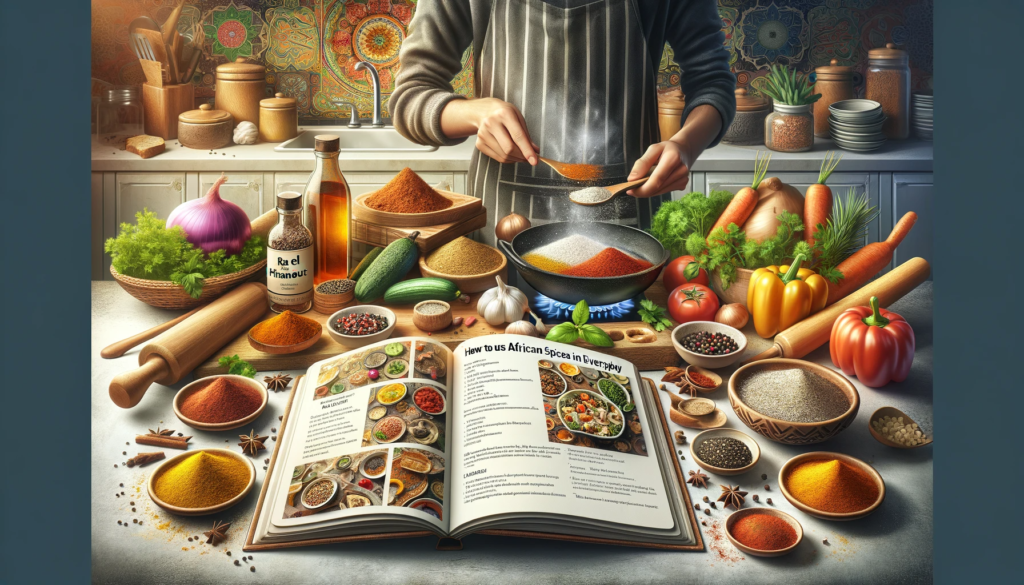Introduction to African Spices in Daily Cuisine
African spices boast a rich heritage, blending influences from indigenous cultures, Arab traders, and European colonizers. These spices offer a gateway to a colorful spectrum of flavors, essential for anyone keen to elevate their cooking repertoire. This guide will introduce you to the world of African spices, providing tips, techniques, and recipes to seamlessly integrate these vibrant flavors into your everyday meals—from the simplicity of breakfast to the indulgence of desserts. Engage your senses and let’s unravel the secrets of African spices to bring an exotic twist to your culinary routine.
Overview of Common African Spices and Their Flavor Profiles
African cuisine is incomplete without mentioning pivotal spices like Berbere, Ras el Hanout, and Dukkah. Berbere, hailing from Ethiopia, is a fiery blend that combines warmth and depth through ingredients like chili peppers, garlic, and fenugreek. Ras el Hanout, originating from North Africa, is a complex mixture of sometimes over twenty spices including cardamom, cumin, and cloves, delivering sweet, floral, and earthy notes. Dukkah, an Egyptian mix, consists chiefly of nuts, seeds like coriander and sesame, and spices, offering a crunchy texture perfect for sprinkling over dishes. Each spice carries its own story and signature, ready to infuse your dishes with an unparalleled essence.
Basic Tips for Cooking with African Spices
Understanding Spice Combinations and Balancing Flavors
African cuisine is about harmony in diversity. When cooking with African spices, it is crucial to comprehend how different flavors work together. A good rule of thumb is to start with fewer spices in smaller amounts to better gauge their impact on a dish. For a balanced taste, pair robust spices like cumin or coriander with milder ones such as paprika or turmeric. This approach allows each spice to contribute to the overall profile without overwhelming the dish. Experimentation is key—feel free to tweak traditional recipes to suit your palate, understanding that the real art lies in the subtle layering of flavors.
Best Practices for Storing and Handling African Spices
To maximize the potency of African spices, proper storage and handling are paramount. Keep spices in airtight containers, away from heat and light, which can degrade their flavors. Whole spices retain their essence longer than ground varieties, so consider investing in a mortar and pestle or a spice grinder to freshly grind spices as needed. Be mindful of the shelf life; spices do not last indefinitely and should generally be replaced every six months to a year for optimal taste. Lastly, when adding spices to a dish, “blooming” them in oil can unlock their full aromatic potential, deepening the flavor profile dramatically.

Simple Techniques to Incorporate African Spices
Enhancing Everyday Meals with African Spices
The versatility of African spices knows no bounds; even simple dishes can be transformed with just a sprinkle or a teaspoon. Spruce up your scrambled eggs with a pinch of Berbere for an Ethiopian touch, or infuse a lentil stew with Ras el Hanout to transport your taste buds to Morocco. African spices easily find their place in marinades, dressings, and soups, instantly boosting the nutritional profile and adding a burst of flavor. Whether you’re roasting vegetables or seasoning grilled meats, incorporating these spices can elevate your dishes from mundane to extraordinary.
Creative Ideas for Breakfast, Lunch, and Dinner
Breakfast can be a canvas for flavor innovation; imagine a warm bowl of oatmeal sprinkled with a dukkah mix for a satisfying crunch and nutty aroma. For lunch, a simple couscous salad can be enriched with a blend of ground coriander, mint, and lemon zest, reflecting a North African zest. Dinner calls for bolder experiments—introduce a tanzanian coconut milk fish curry to your dining table, showcasing a mouthwatering combination of cardamom, turmeric, and ginger, enticing all who partake. African spices make each meal an adventurous sojourn, transforming your daily dining into a cultural exploration.

Spice-Infused Main Dishes and Sides
Recipes for Main Courses Utilizing African Spices
Indulge in the robust flavors of a Moroccan Tagine, featuring a harmonious blend of cinnamon, ginger, and saffron that tenderize and perfume the meat as it slow-cooks to perfection. Alternatively, try your hand at a South African Bobotie—a savory, spiced mince bake topped with an egg custard, subtly flavored with curry powder and turmeric. For a vegetarian option, Ethiopian Misir Wot, a hearty lentil stew rich in Berbere’s smoky warmth, is sure to satisfy. These main courses encapsulate the depth and breadth of African spices, inviting an exotic zest to your dinner table.
Side Dishes and Accompaniments Enhanced by African Flavors
Sides can be more than just supporting acts; they hold the potential to shine when accentuated by the right spices. Facilitate a sensory journey with an Egyptian-style rice pilaf, enlivened by a medley of aromatic cardamom, cumin, and cinnamon, or offer a refreshing twist to a simple cucumber salad with a sprinkle of sumac for a tart, lemony edge. Let’s not forget the staple of West African cooking, Jollof rice, with its base of tomatoes and peppers, permeated by thyme, curry, and white pepper, creating a vibrant accompaniment that could easily steal the spotlight on any plate.
African Spices in Snacks and Beverages
Snack Recipes Featuring African Spices
Elevate your snack game with small bites that pack a punch. Take roasted almonds or chickpeas to new heights by tossing them in a mix of smoked paprika, cumin, and a hint of cayenne for a savory, spicy treat. Or, delve into the flavors of the Sahara with an aromatic sweet potato hummus, enriched with a swirl of harissa paste, providing a delectable Tunisian twist. Snacking is not just about sating hunger—it’s an opportunity to savor the diverse palettes of the African continent, one delicious bite at a time.
African-Inspired Spiced Beverages and Drinks
Thirst-quenching drinks also serve as a medium to showcase African spices. A cold glass of Hibiscus tea, known as ‘Bissap’ in West Africa, reveals tangy, floral notes and is splendidly refreshing on a hot day. Or, consider a warm mug of spiced Ethiopian coffee, imbued with cardamom and cloves, creating an intoxicating aroma that stimulates the senses. These beverage traditions not only provide solace and hydration but also connect us to the rituals and cultures where these spices play an integral role.
Desserts with a Touch of African Spice
Sweet Treats and Desserts Incorporating African Spices
Introduce exotic flair into your desserts by infusing them with the enchanting flavors of African spices. A North African-inspired orange cake, perfumed with orange blossom water and garnished with a dusting of cinnamon, can elevate the dessert experience with its delicate spice notes. Or consider a rich and creamy malva pudding, a beloved South African dessert that incorporates apricot jam and often features a subtle hint of allspice. These sweet offerings promise to whisk diners away on a voyage of spice-infused indulgence, adding an unforgettable final note to any meal.
Baking with African Spices: Tips and Recipes
The art of baking can be greatly enhanced by incorporating African spices. Whether you’re folding fragrant nutmeg into your dough for traditional Nigerian puff-puffs or swirling cinnamon and ginger into a Tunisian baklava, baking with these spices transcends the ordinary. However, it’s important to balance the proportions to ensure the spices complement rather than overwhelm the baked goods. The key is to start with smaller quantities, allowing the spices to subtly enhance flavors, and adjusting these amounts according to your taste preferences and the nature of your baked marvels.
FAQs on Using African Spices in Everyday Cooking
How do I begin experimenting with African spices if I’m new to them?
Start by picking a single spice or a blend, such as Ras el Hanout or Berbere, and use it in a familiar dish to experience its flavor. Use it sparingly at first, then adjust to taste as you become more comfortable. Reading recipes and watching culinary shows that feature African cuisine can also provide inspiration and guidance on how to integrate these spices into your cooking.
What’s the best way to store African spices to maintain their flavor?
Store your spices in airtight containers in a cool, dark place to protect them from heat and light, which diminish their potency. Whole spices last longer than ground, so consider buying them whole and grinding them as needed. It’s generally recommended to replace spices every six months to a year to ensure they remain fresh and flavorful.
Are there any spicy heat considerations when using African spices?
Yes, African spices range from mild to very hot. Berbere and peri-peri, for example, deliver significant heat. If you’re sensitive to spicy foods, start with milder spices or blends, and gradually work your way up to hotter varieties, adjusting quantities to suit your heat tolerance.
Can African spices be used in vegetarian and vegan dishes?
Absolutely! African spices can add depth and complexity to vegetarian and vegan dishes. They work particularly well in stews, grains, and legumes, infusing plant-based dishes with rich, savory flavors without the need for animal products.
Is it possible to blend African spices with other culinary traditions?
Indeed, African spices can be blended with various culinary traditions for unique and innovative dishes. The robust flavors of African spices can complement Asian, European, and American cuisines, among others, creating fusion dishes that are both exciting and delicious.
